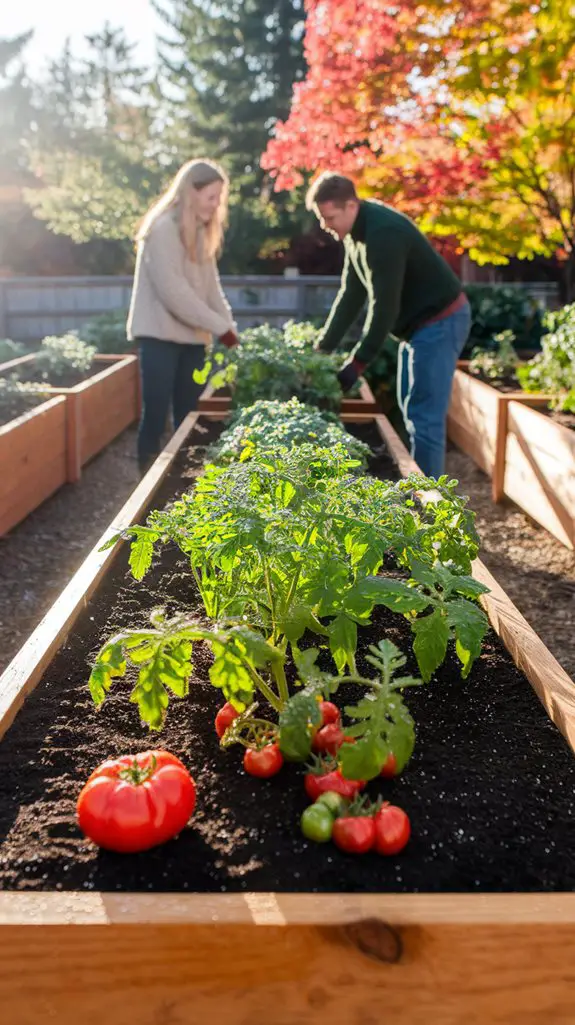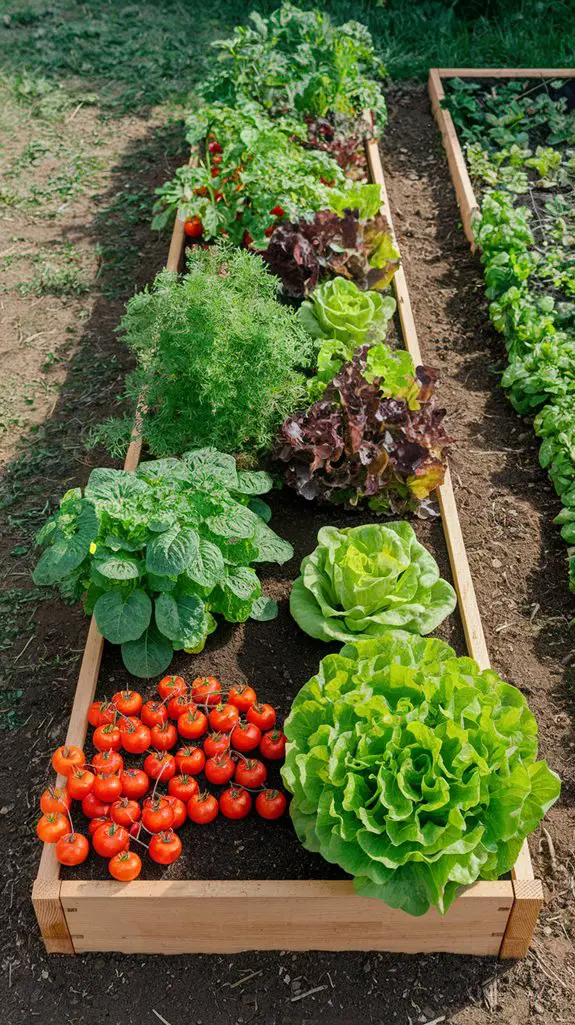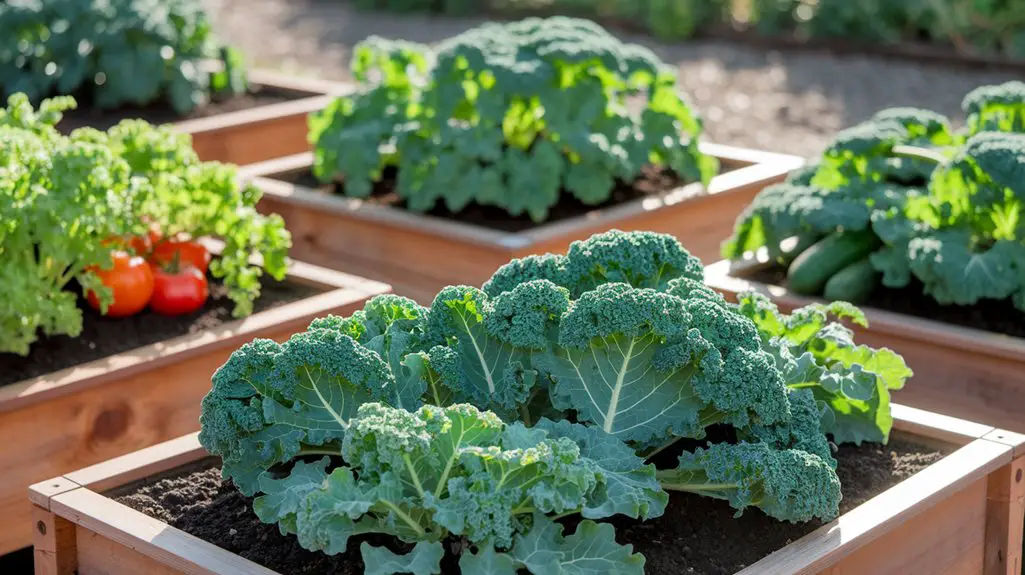When you invest in raised garden beds for your vegetable cultivation, you’re making a strategic choice that elevates both your gardening experience and harvest potential. These structured growing environments offer precise soil control, improved drainage, and reduced maintenance burdens while extending your growing season. They shield your plants from common threats while making gardening more physically accessible. The benefits extend well beyond aesthetics—your vegetables will likely grow faster, stronger, and more abundantly in these optimized conditions.
Soil Quality Control and Improved Drainage
When constructing raised garden beds, you’ll gain precise control over soil composition, one of the primary advantages of this gardening method. You can create ideal growing conditions by combining topsoil, compost, and amendments specifically matched to your vegetables’ requirements. This customized medium allows you to bypass poor native soil conditions entirely.
Raised beds inherently provide superior drainage compared to in-ground gardens. The elevated structure prevents waterlogging during heavy rainfall, as excess moisture efficiently channels through the soil column.
This drainage capability reduces root rot risks and fungal diseases that commonly plague vegetables in saturated conditions. The improved aeration within raised bed soil also promotes beneficial microbial activity and facilitates stronger root development, establishing a foundation for robust plant growth throughout the growing season. Additionally, the ability to customize soil allows gardeners to experiment with different blends to optimize nutrient availability for various crops.
Extended Growing Seasons and Earlier Harvests

Raised garden beds offer significant temperature advantages that effectively extend your growing season beyond traditional garden limitations. The elevated soil warms faster in spring, allowing you to plant 2-3 weeks earlier than in-ground gardens.
You’ll also benefit from prolonged fall harvests as the contained soil retains heat longer after ambient temperatures drop. This thermal advantage is measurable—raised beds typically maintain soil temperatures 8-13°F higher than ground-level gardens during critical shifting periods.
For cool-climate gardeners, this temperature differential translates directly to increased yield potential through longer cultivation periods. Install season extenders like cold frames or hoop covers over your raised beds to push these benefits even further, potentially achieving near-year-round production in many growing zones. Additionally, backyard vegetable gardening is simplified as raised beds allow for better soil management and accessibility.
The combination creates microclimates that protect tender seedlings from late frosts and mature plants from early freezes.
Weed Prevention and Reduced Maintenance

One of the most significant advantages of raised garden beds is their inherent ability to minimize weed pressure through multiple passive mechanisms. You’ll eliminate dormant weed seeds by importing clean soil rather than utilizing existing ground. The elevated structure creates a physical barrier against rhizomatous weeds that typically spread horizontally.
| Weed Control Method | Mechanism | Maintenance Reduction |
|---|---|---|
| Soil isolation | Prevents existing seed bank access | 70-80% fewer weeds |
| Dense planting | Creates vegetative competition | Reduces open soil exposure |
| Mulch application | Blocks light to soil surface | Suppresses germination |
| Defined pathways | Prevents edge encroachment | Simplifies monitoring |
| Barrier installation | Blocks weed rhizomes | Eliminates perennial invasions |
Additionally, raised beds’ improved drainage and soil structure facilitate easy extraction of any weeds that do emerge, enabling complete root removal without disturbing vegetable root systems.
Accessibility and Ergonomic Benefits for Gardeners
Many gardeners report 40-60% less physical strain when tending raised beds compared to traditional ground-level plots. This reduction results from the elevated working height, which eliminates excessive bending and kneeling that often trigger back pain and joint stress.
You’ll appreciate the customizable heights of raised beds—typically 24-36 inches—allowing you to garden while standing or seated. This feature makes vegetable gardening accessible for wheelchair users, elderly gardeners, and those with mobility limitations.
The ergonomic advantages extend to maintenance tasks as well. Weeding, harvesting, and soil amendments require less reaching and stretching.
Strategic bed width (typically 3-4 feet) guarantees you can reach the center from either side without strain, optimizing your gardening efficiency while minimizing physical exertion. Additionally, raised garden beds can improve drainage and soil quality, which is essential for healthy vegetable growth.
Space Efficiency and Higher Vegetable Yields
While traditional garden plots often waste up to 30% of available space on pathways and borders, raised beds maximize growing area through strategic design and intensive planting techniques.
You’ll achieve 1.5 to 2 times greater yields in raised beds through square foot gardening methods, which optimize plant spacing in grids rather than rows.
The defined boundaries of raised beds enable companion planting and vertical growing without soil compaction. You can position climbing vegetables along trellises at the bed’s northern edge while planting shallow-rooted crops beneath them.
The improved soil structure promotes deeper root penetration, allowing you to space plants 15-20% closer together than conventional gardens. This density creates a beneficial microclimate that suppresses weeds, conserves moisture, and maximizes photosynthesis—all contributing to markedly higher production per square foot. Additionally, raised beds can enhance soil health and structure by allowing for better aeration and drainage compared to traditional in-ground gardens.
Protection From Pests and Lawn Equipment
Beyond their yield advantages, raised garden beds establish effective barriers against common garden threats. The elevated design naturally deters crawling pests like slugs and snails, while creating a clear boundary that reduces accidental trampling.
You’ll find it easier to install protective measures such as mesh covers, row covers, or fencing directly onto the beds’ frames.
The distinct borders of raised beds also protect your vegetables from lawn maintenance equipment. No more vegetable casualties from wayward lawn mowers or string trimmers.
The physical separation creates a safety zone that preserves plant integrity and reduces soil compaction that typically occurs when maneuvering around in-ground gardens. This structural protection ultimately minimizes plant stress, decreases pest vulnerability, and maintains ideal growing conditions throughout the vegetable garden’s productive lifecycle. Additionally, incorporating natural pest control techniques can further enhance the effectiveness of your raised garden beds.
Customization Options for Different Vegetable Needs
Raised garden beds offer remarkable versatility through customization options that address specific vegetable requirements.
You can adjust soil depth, composition, and drainage to match the needs of different crops. Root vegetables require deeper beds, while leafy greens thrive in shallower systems with nitrogen-rich soil.
- Variable depths – Configure bed heights from 6″ for shallow-rooted lettuce and herbs to 18″+ for carrots, potatoes, and root vegetables that need extensive vertical space.
- Sectioned compartments – Install dividers to separate incompatible plants or create microclimates with different soil pH levels for acid-loving versus alkaline-preferring vegetables.
- Integrated trellising – Attach customized support structures directly to bed frames for climbing varieties such as peas, cucumbers, and tomatoes.
Additionally, raised beds can enhance vertical growth by maximizing space and improving air circulation for the plants.
Conclusion
You’ve discovered the empirical truth behind raised bed gardening’s success: it’s not just gardening folklore but scientifically validated cultivation methodology. By implementing these structured growing environments, you’ll optimize soil composition, thermal properties, and spatial efficiency while minimizing pathogen vectors and ergonomic strain. The evidence confirms that raised beds represent a technical solution to common cultivation limitations, delivering measurable improvements in both crop yield and gardening sustainability.




